Adaptive Continuous Non-Singular Terminal Sliding Mode Control for High-Pressure Common Rail Systems: Design and Experimental Validation
Abstract
1. Introduction
2. HPCRS Modeling and Control Problem Statement
2.1. Problem Statement and Modeling
- The dynamics of the solenoid valve and temperature-related variations are neglected;
- The fuel dynamics are considered as one-dimensional, unsteady, and laminar flow;
- Pressure wave transmission between the low- and high-pressure circuits is not considered;
- The hydrodynamic phenomena occurring in the connecting pipes are also deemed negligible;
- Since the injection interval is extremely short, the dynamics of the injector are not taken into account.
2.2. Model Simplification and Problem Statement
- (1)
- When ξ = 0, it indicates that the pump pressure is lower than the rail pressure, i.e., pp ≤ pr [8]. According to Equations (1)–(8), the dynamics equation of HPCRS in this scenario can become:
- (2)
- When ξ = 1, it corresponds to the scenario in which the pump pressure exceeds the rail pressure, i.e., pp > pr. the dynamics equation of HPCRS can become:
3. Adaptive CNTSMC Design
3.1. Improved CNTSMC Design
3.2. Adaptive Mechanism Design
4. Experimental Validation and Analysis
4.1. Engineering Realization
4.2. Experimental Setup
4.3. Experimental Comparison
5. Conclusions
Author Contributions
Funding
Data Availability Statement
Conflicts of Interest
Abbreviations
| HPCRS | High-pressure common rail system |
| SMC | Sliding mode control |
| LSMC | Linear sliding mode control |
| TSMC | Terminal sliding mode control |
| CSMC | Continuous sliding mode control |
| ACNTSMC | Adaptive continuous non-singular terminal sliding mode control |
| ECU | Electronic control unit |
References
- Ma, C.; Song, E.Z.; Yao, C.; Long, Y.; Ding, S.L.; Xu, D.; Liu, Z.L. Multi-objective optimization of dual-fuel engine performance in PPCI mode based on preference decision. Fuel 2022, 312, 122901. [Google Scholar] [CrossRef]
- Ma, C.; Song, E.Z.; Yao, C.; Long, Y.; Ding, S.L.; Xu, D. Analysis of PPCI mode and multi-objective comprehensive optimization for a dual-fuel engine. Fuel 2021, 303, 121296. [Google Scholar] [CrossRef]
- Long, Y.; Liu, X.; Yao, C.; Song, E. Model-free adaptive full-order sliding mode control with time delay estimation of high-pressure common rail system. J. Vib. Control 2023, 31, 2271–2284. [Google Scholar] [CrossRef]
- Wang, H.P.; Zheng, D.; Tian, Y. High pressure common rail injection system modeling and control. ISA Trans. 2016, 63, 265–267. [Google Scholar] [CrossRef] [PubMed]
- Catania, A.E.; Ferrari, A.; Manno, M.; Spessa, E. Experimental investigation of dynamics effects on multiple-injection common rail system performance. J. Eng. Gas Turbines Power 2008, 130, 132–141. [Google Scholar] [CrossRef]
- Ferrari, A.; Paoliceli, F. Modal analysis of fuel injection systems and the determination of transfer function between rail pressure and injection rate. J. Eng. Gas Turbines Power 2018, 140, 278–287. [Google Scholar] [CrossRef]
- Liu, Q.; Chen, H.; Hu, Y.; Sun, P.; Li, J. Modeling and control of the fuel injection system for rail pressure regulation in GDI engine. IEEE/ASME Trans. Mechatron. 2014, 19, 1501–1513. [Google Scholar]
- Chen, H.; Gong, X.; Liu, Q.; Hu, Y. Triple-step method to design non-linear controller for rail pressure of gasoline direct injection engines. IET Control Theory Appl. 2014, 8, 948–959. [Google Scholar] [CrossRef]
- Wang, J.; Sun, H.; Dai, C.; Li, S. GPIO-based rail pressure control for diesel high pressure common rail injection system. J. Eng. 2019, 88, 8293–8298. [Google Scholar] [CrossRef]
- Wang, H.; Tian, Y.; Zheng, D. ESO-based iPI Common Rail Pressure Control of High Pressure Common Rail Injection System. Stud. Inform. Control 2016, 25, 273–282. [Google Scholar] [CrossRef]
- Ling, J.; Li, J.; Wang, X.; Li, Y.; An, X.; Xie, Z. Research on ADRC Based Control Algorithm of Common Rail Pressure for Diesel Engines. In Proceedings of the IEEE International Conference on Artificial Intelligence and Information Systems (ICAIIS), Dalian, China, 20–22 March 2020; pp. 656–660. [Google Scholar]
- Xiang, S.; Ji, J.M.; Mo, G.Q.; Sun, D.A. Diesel common rail pressure control based on feed forward fuzzy PID controller. In Proceedings of the 3rd International Conference on Energy Science and Application Technology (ESAT), Wuhan, China, 27–29 May 2016; pp. 55–60. [Google Scholar]
- Zhang, C.; Sun, D.; Pang, K.; Zou, L.; Martínez, L.; Pedrycz, W. A high-order hesitancy fuzzy time series model based on improved cumulative probability distribution approach and weighted fuzzy logic relationship. Inf. Sci. 2025, 717, 122262. [Google Scholar] [CrossRef]
- Tang, X.; Liao, Y.; Gu, J.; Zhou, Y.; Guan, X. Optimization of wide-area multilateration ground station deployment based on genetic algorithm. Proc. Inst. Mech. Eng. Part G J. Aerosp. Eng. 2025, 239, 646–657. [Google Scholar] [CrossRef]
- Wang, S.; Chu, T.; Wasi, M.; Guerra, R.M.; Yuan, X.; Wang, L. Prognostic assessment of osteolytic lesions and mechanical properties of bones bearing breast cancer using neural network and finite element analysis. Mechanobiol. Med. 2025, 3, 100130. [Google Scholar] [CrossRef] [PubMed]
- Lino, P.; Maione, B.; Rizzo, A. Nonlinear modelling and control of a common rail injection system for diesel engines. Appl. Math. Model. 2007, 31, 1770–1784. [Google Scholar] [CrossRef]
- Hu, R.; Wu, D.; You, Z.; Wu, D.; Tu, W. Predefined-time terminal sliding mode cooperative trajectory tracking control for USV-AUV under weak communication. Ocean Eng. 2025, 333, 121459. [Google Scholar] [CrossRef]
- Shi, S.; Dai, L.; Min, H.; Hu, Y. Non-singular terminal sliding mode controller design for nonlinear systems with prescribed convergence time guarantees. Int. J. Robust Nonlinear Control 2023, 34, 2597–2613. [Google Scholar] [CrossRef]
- Zhong, E.; Wang, S.; Zhai, C.; Li, W. Improved non-singular fast terminal sliding mode control with hysteresis compensation for piezo-driven fast steering mirrors. Actuators 2025, 14, 170. [Google Scholar] [CrossRef]
- Levant, A. Principles of 2-sliding mode design. Automatica 2007, 43, 576–586. [Google Scholar] [CrossRef]
- Utkin, V. On convergence time and disturbance rejection of super-twisting control. IEEE Trans. Autom. Control 2013, 58, 2013–2017. [Google Scholar] [CrossRef]
- Feng, Y.; Han, F.; Yu, X. Chattering free full-order sliding-mode control. Automatica 2014, 50, 1310–1314. [Google Scholar] [CrossRef]
- Prinz, K.; Kemmetmueller, W.; Kugi, A. Mathematical modelling of a diesel common-rail system. Math. Comput. Model. Dyn. Syst. 2015, 21, 311–335. [Google Scholar] [CrossRef]
- Lino, P.; Maione, B.; Rizzo, A. A control-oriented model of a common rail injection system for diesel engines. In Proceedings of the 10th IEEE International Conference on Emerging Technologies and Factory Automation, Catania, Italy, 19–22 September 2005; pp. 557–563. [Google Scholar]
- Wang, Q.; Yao, H.; Yu, Y.; Yang, J.; He, Y. Establishment of a real-time simulation of a marine high-pressure common rail system. Energies 2021, 14, 5481. [Google Scholar] [CrossRef]
- Ferrari, A.; Pizzo, P. Fully predictive common rail fuel injection apparatus model and its application to global system dynamics analyses. Int. J. Engine Res. 2017, 18, 273–290. [Google Scholar] [CrossRef]
- Gao, Z.G.; Li, H.M.; Xu, C.L.; Li, G.X.; Wang, M. Control strategy based on flow conservation equation for high-pressure common rail system. Int. J. Automot. Technol. 2022, 23, 793–803. [Google Scholar] [CrossRef]
- Yan, F.; Wang, J. Common rail injection system iterative learning control based parameter calibration for accurate fuel injection quantity control. Int. J. Automot. Technol. 2011, 12, 149–157. [Google Scholar] [CrossRef]
- Bhat, S.P.; Bernstein, D.S. Geometric homogeneity with applications to finite-time stability. Math. Control. Signals Syst. 2005, 17, 101–127. [Google Scholar] [CrossRef]
- Rabiee, H.; Ataei, M.; Ekramian, M. Continuous nonsingular terminal sliding mode control based on adaptive sliding mode disturbance observer for uncertain nonlinear systems. Automatica 2019, 12, 109–116. [Google Scholar] [CrossRef]
- Long, Y.; Yao, C.; Song, E.Z. Design and experimental analysis of an adaptive second-order fast non-singular terminal sliding mode controller for electronic throttle with disturbance. IEEE Access 2023, 11, 57854–57866. [Google Scholar] [CrossRef]
- Shtessel, Y.; Taleb, M.; Plestan, F. A novel adaptive-gain supertwisting sliding mode controller: Methodology and application. Automatica 2012, 48, 759–769. [Google Scholar] [CrossRef]


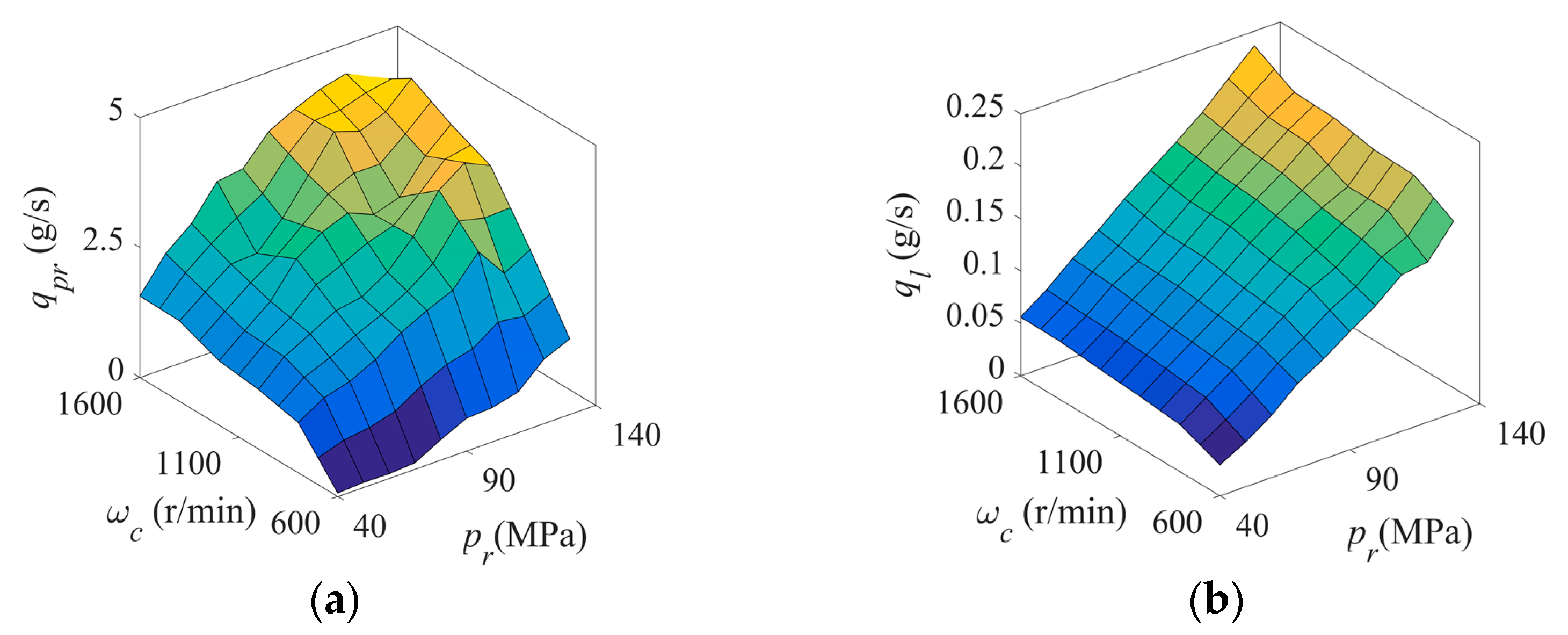
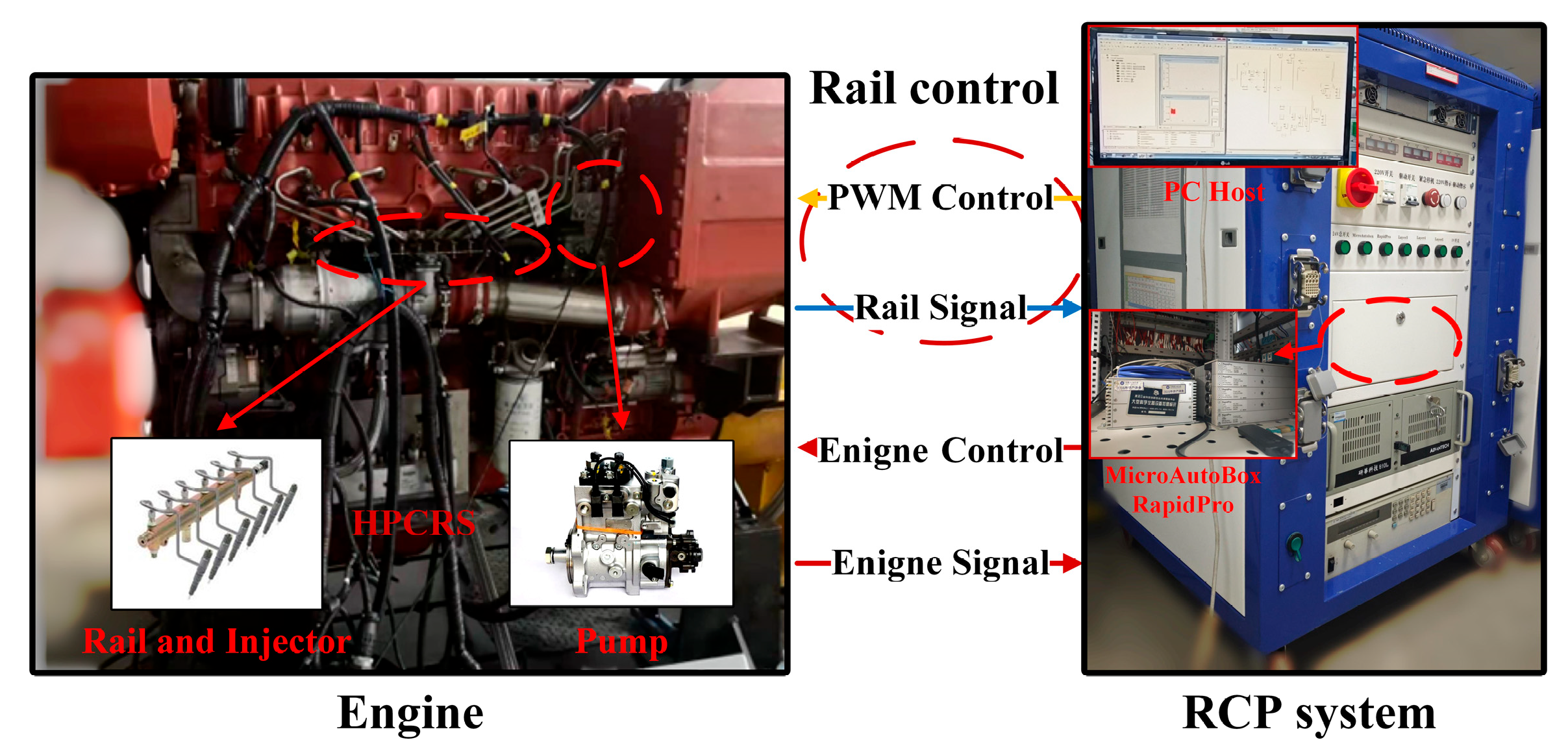
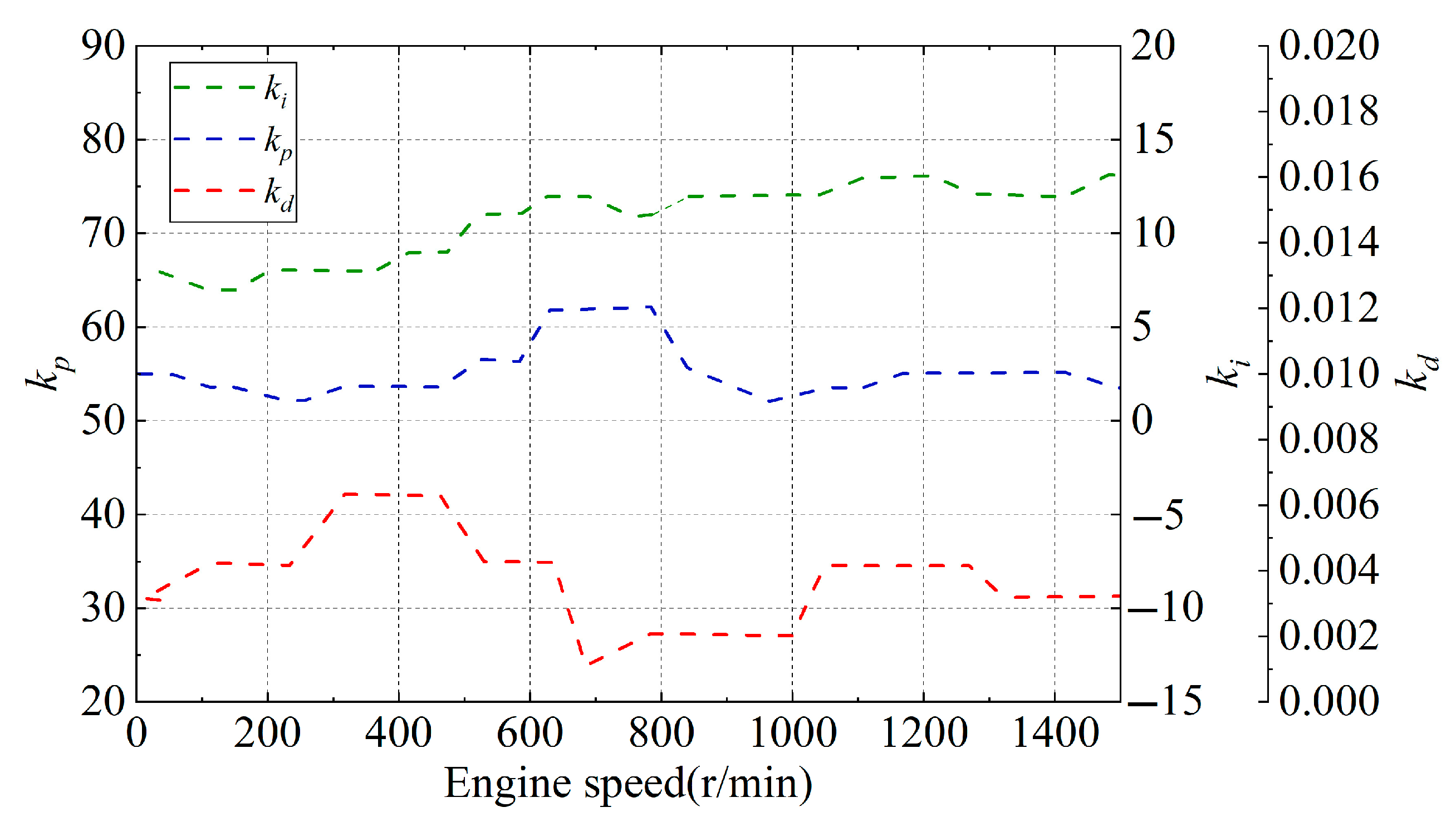
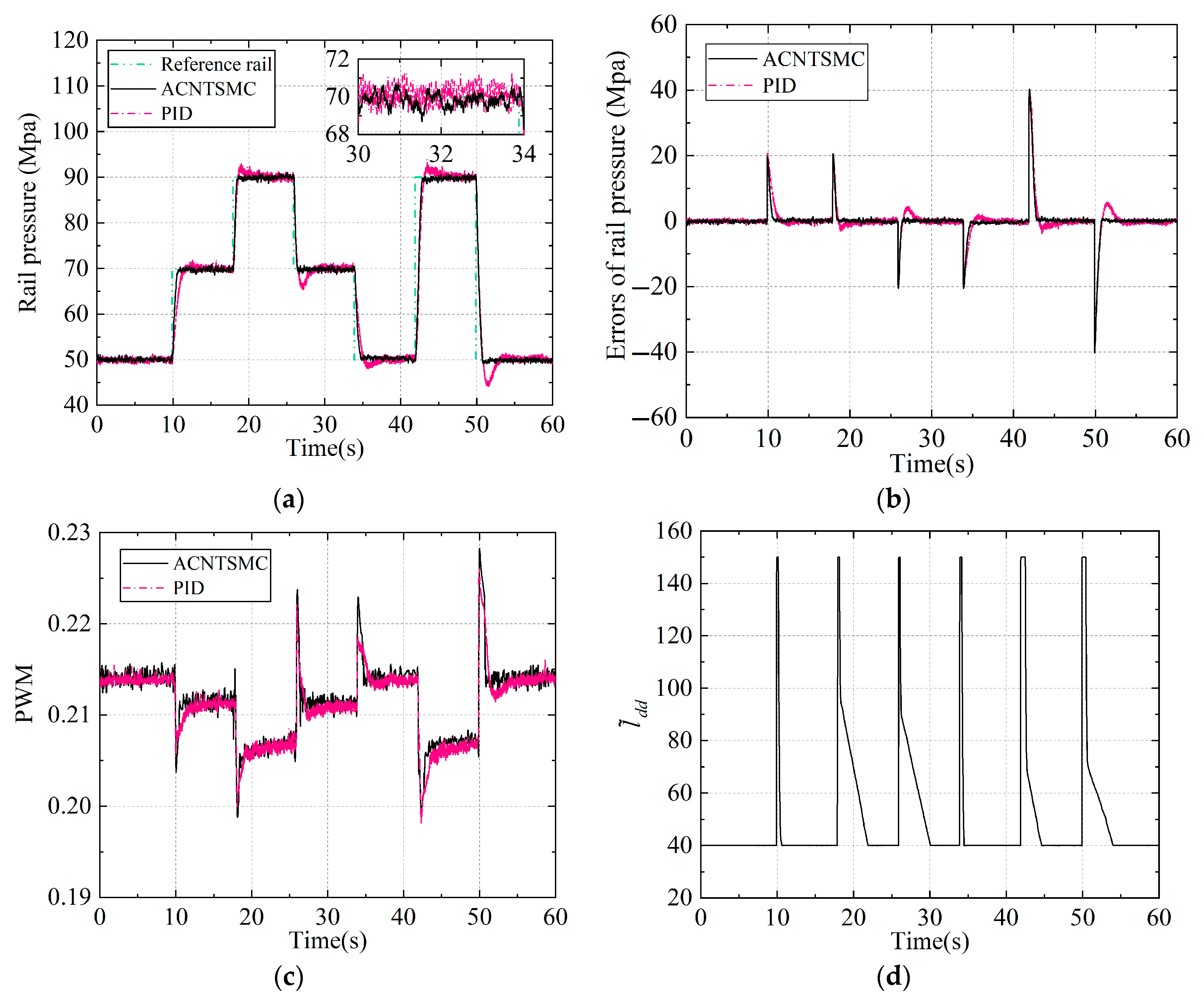

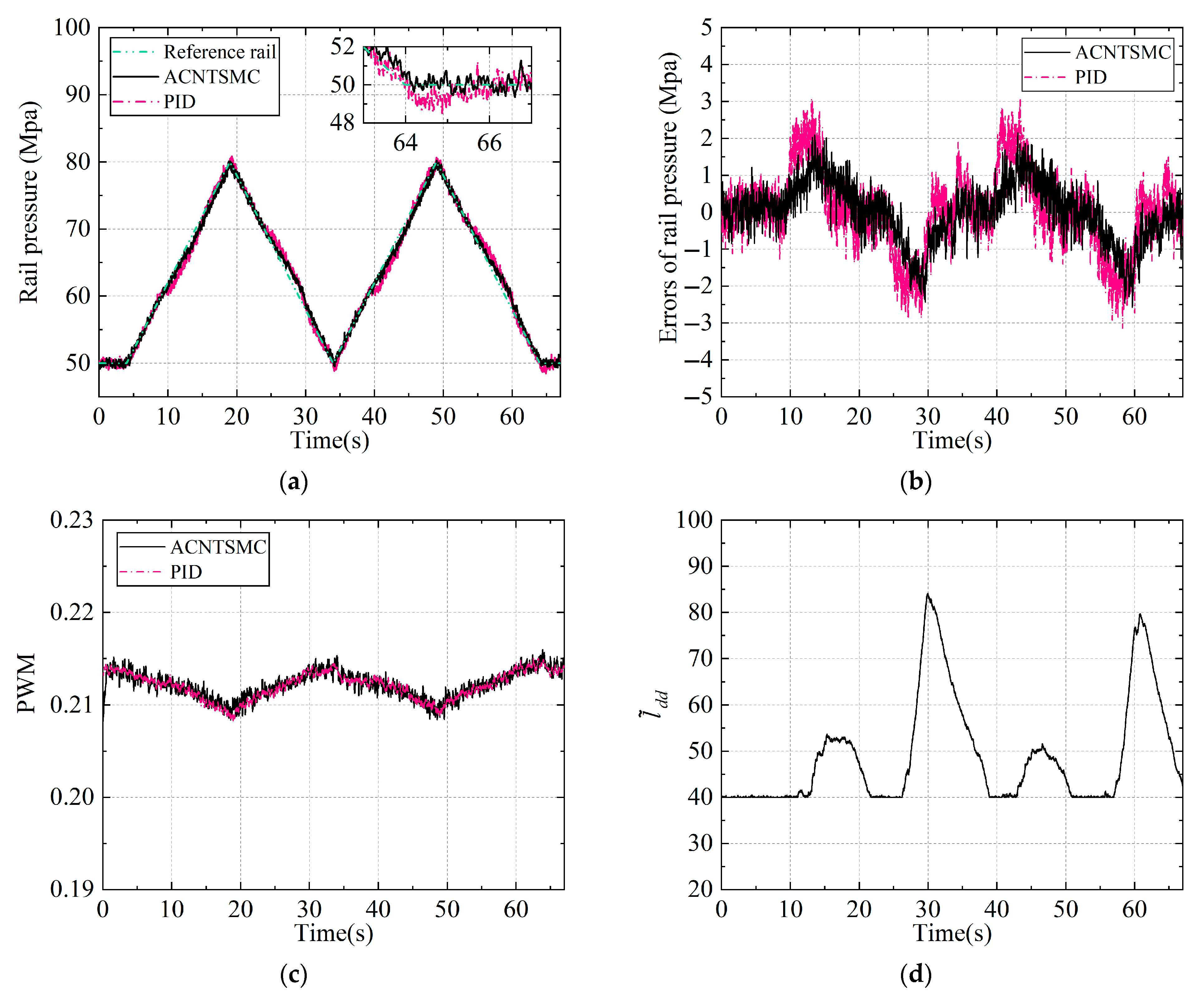
| Parameters | Specification |
|---|---|
| Nominal engine speed | 1500 r/min |
| Rated output power | 255 kW |
| Peak injection pressure | 1500 bar |
| Cylinder configuration | 6-inline |
| Compression ratio | 16.5:1 |
| Total engine displacement | 12.155 L |
| Piston stroke | 155 mm |
| Cylinder bore diameter | 129 mm |
| Case | Engine Speed | Load Torque | Reference Rail Pressure | Special Condition |
|---|---|---|---|---|
| 1 | 1000 r/min | 600 N·m | Varying-amplitude step changes 90→50 MPa | Step reference pressure signal with multiple amplitude steps |
| 2 | 1000 r/min | Sudden 600 N·m torque | Fixed at 70 MPa | Torque disturbance inducing engine speed variation |
| 3 | 1000 r/min | Not specified | Continuously varying ramp 50→80 MPa linearly | Time-varying ramp reference pressure signal |
| Controller | MAX (e) (MPa) | RMS (e) (MPa) | Settling Time (s) | Overshoot | |
|---|---|---|---|---|---|
| Case 1 | ACNTSMC | 1.56 | 0.41 | 1.0 | 5.5 MPa |
| PID | 2.77 | 1.07 | 3.2 | -- | |
| Case 2 | ACNTSMC | 2.1 | 0.52 | 3.2 | 9.8 MPa |
| PID | 9.2 | 1.83 | 5.5 | 4.3 MPa | |
| Case 3 | ACNTSMC | 2.24 | 0.46 | -- | -- |
| PID | 3.16 | 1.22 | -- | -- |
Disclaimer/Publisher’s Note: The statements, opinions and data contained in all publications are solely those of the individual author(s) and contributor(s) and not of MDPI and/or the editor(s). MDPI and/or the editor(s) disclaim responsibility for any injury to people or property resulting from any ideas, methods, instructions or products referred to in the content. |
© 2025 by the authors. Licensee MDPI, Basel, Switzerland. This article is an open access article distributed under the terms and conditions of the Creative Commons Attribution (CC BY) license (https://creativecommons.org/licenses/by/4.0/).
Share and Cite
Zhang, J.; Yu, Y.; Wu, S.; Zhu, W.; Liu, W. Adaptive Continuous Non-Singular Terminal Sliding Mode Control for High-Pressure Common Rail Systems: Design and Experimental Validation. Processes 2025, 13, 2410. https://doi.org/10.3390/pr13082410
Zhang J, Yu Y, Wu S, Zhu W, Liu W. Adaptive Continuous Non-Singular Terminal Sliding Mode Control for High-Pressure Common Rail Systems: Design and Experimental Validation. Processes. 2025; 13(8):2410. https://doi.org/10.3390/pr13082410
Chicago/Turabian StyleZhang, Jie, Yinhui Yu, Sumin Wu, Wenjiang Zhu, and Wenqian Liu. 2025. "Adaptive Continuous Non-Singular Terminal Sliding Mode Control for High-Pressure Common Rail Systems: Design and Experimental Validation" Processes 13, no. 8: 2410. https://doi.org/10.3390/pr13082410
APA StyleZhang, J., Yu, Y., Wu, S., Zhu, W., & Liu, W. (2025). Adaptive Continuous Non-Singular Terminal Sliding Mode Control for High-Pressure Common Rail Systems: Design and Experimental Validation. Processes, 13(8), 2410. https://doi.org/10.3390/pr13082410






